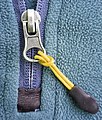Anchor stitch
| Anchor stitch | |
|---|---|

|
|
| Type | Mooring lines |
| application | Attach a loop to a post or ring |
| Ashley No. | 5, 244, (2540) |
| English | Bale Sling Hitch, Ring Hitch, Cow Hitch, Lark's Head |
| List of nodes | |
The anchor stitch is a simple mooring knot that is easy to tie. The name refers to a sailor's knot, but the knot is so simple that it is widely used in everyday life too. Mostly it is used to attach a loop to an object. It is characteristic that it pulls itself shut and yet can easily be released again. It is therefore unsuitable for rescuing people , but it is an advantage, for example, to pull up equipment.
use
As a fire brigade knot, the anchor hitch is ideal for securing devices or hoses. There it is called double anchor stitch .
The anchor stitch is used as a securing knot in hook eyes when climbing. It is often used with slings , for example to secure it to a tree. In rope teams with three or more climbers, there is another application as a rope knot for the middle rope team members. To do this, you make a large loop using a butterfly knot and tie it to the climbing harness with an anchor stitch by pulling it through the rope loop and then climbing through it with your whole body.
In archery it is used for the D-loop on the bowstring.
The knotting macrame and Scoubidou it serves, among other things as a starting point for various Plattings .
photos
Make the anchor stitch with a round sling
Modifications
The anchor stitch can be seen as a "basic knot", which can take several forms when modified:
- short trumpet : multiple twisted anchor stitch design.
- Prusik knot : double or multiple anchor stitch execution (of the eyes)
- Square knot : an "overturned" anchor stitch (e.g. when two endless loops are connected with one anchor stitch and tightened.)
If the pull is to be expected from only one strand, the loom line is more suitable in most cases.
hazards
The anchor stitch is popular because it is easy to pin and easy to loosen even after stress. It is suitable for situations in which both rope ends are loaded equally. If only one side is loaded, the anchor stitch can rustle or - if the ring has a small radius - tip over and unintentionally loosen. In such a case, a mast throw or a round trip with two half strokes is much safer .

